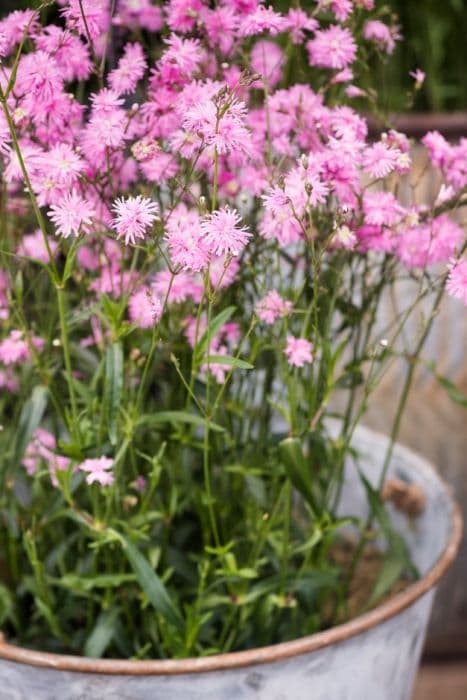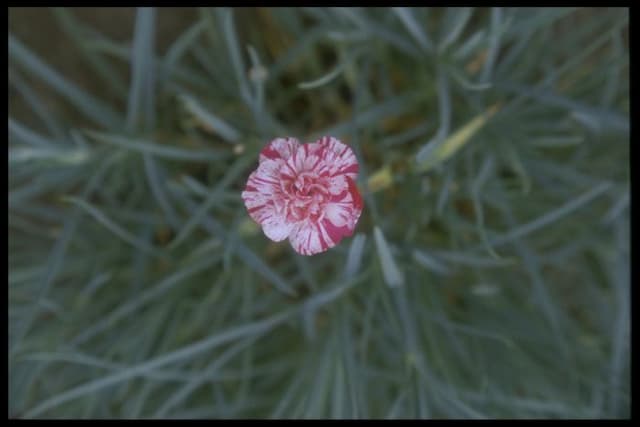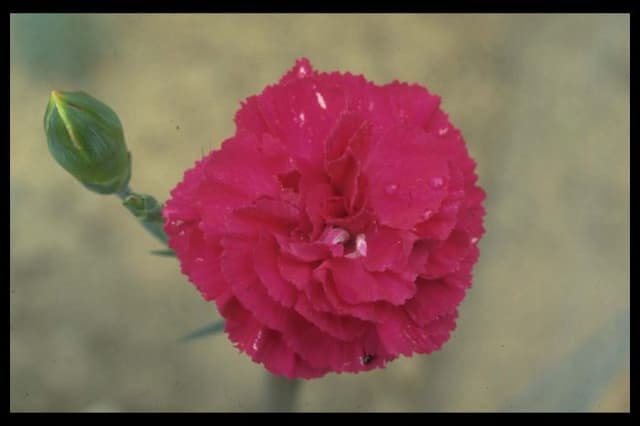Ragged robin 'Petite Jenny' Lychnis flos-cuculi 'Petite Jenny' (d)

ABOUT
'Petite Jenny' is a compact, upright perennial to 35cm tall with branched stems bearing lance-shaped leaves. Clusters of soft pink, finely cut, double flowers are borne from late spring into early summer
About this plant
 Names
NamesFamily
Caryophyllaceae.
Synonyms
Ragged Robin 'Petite Jenny', Meadow Campion 'Petite Jenny', Cuckoo Flower 'Petite Jenny'.
Common names
Silene flos-cuculi, Lychnis flos-cuculi
 Characteristics
CharacteristicsLife cycle
Perennials
Foliage type
Deciduous
Color of leaves
Green
Flower color
Pink
Height
1-2 feet (30-60 cm)
Spread
1-1.5 feet (30-45 cm)
Plant type
Herb
Hardiness zones
4-8
Native area
Europe
Benefits
 General Benefits
General Benefits- Attracts Pollinators: The plant is known to attract bees, butterflies, and other beneficial insects which help in pollination.
- Low Maintenance: 'Petite Jenny' requires minimal care once established, making it suitable for gardeners with busy schedules or beginners.
- Drought Tolerant: It has good tolerance to dry conditions, reducing the need for frequent watering.
- Decorative Flowers: The plant produces attractive, fluffy pink flowers that enhance the visual appeal of gardens and landscapes.
- Wildlife Friendly: It provides a habitat and food source for wildlife, particularly beneficial insects and birds.
- Long Blooming: It has a prolonged flowering period, often from late spring to early summer, offering a sustained display of blooms.
- Easy Propagation: The plant can be easily propagated by dividing clumps or from seed, making it simple to expand your garden or share with others.
- Cold Hardy: It is capable of withstanding cold temperatures, making it a suitable choice for gardens in cooler climates.
 Medical Properties
Medical PropertiesThis plant is not used for medical purposes.
 Air-purifying Qualities
Air-purifying QualitiesThis plant is not specifically known for air purifying qualities.
 Other Uses
Other Uses- Ragged Robin can be used as a natural dye for fabrics, producing a range of colors depending on the mordant used.
- It can provide a food source for caterpillars of certain butterfly species, supporting biodiversity in a garden.
- The plant is suitable for creating a 'wild look' in informal garden planting schemes, enhancing aesthetic diversity.
- Ragged Robin’s nectar-rich flowers are ideal for attracting and feeding bees and other pollinators in a wildlife-friendly garden.
- The tall, slender stems of Ragged Robin can add visual interest and height in cut flower arrangements.
- Dried seed heads of Ragged Robin can be utilized in dry flower arrangements for a rustic appeal.
- The plant can be used in educational settings to teach about native flora and the significance of preserving wildflower varieties.
- Ragged Robin can serve as a pond-edge plant, offering structural variety and attracting amphibians to the garden habitat.
- It may be used in floral photography due to its unique appearance and vibrant pink flowers, providing natural backdrops.
- The flowering period of Ragged Robin can be used to indicate the transition from spring to summer in a phenological garden or study.
Interesting Facts
 Feng Shui
Feng ShuiThe plant Ragged Robin is not used in Feng Shui practice.
 Zodiac Sign Compitability
Zodiac Sign CompitabilityThe plant Ragged Robin is not used in astrology practice.
 Plant Symbolism
Plant Symbolism- Youthfulness: The Lychnis flos-cuculi, commonly known as Ragged Robin, has a delicate and whimsical appearance, symbolizing innocence and the carefree days of youth.
- Romantic Love: Its vibrant pink petals are often associated with feelings of love and affection, making it a symbol of romantic love.
- Adaptability: Ragged Robin is known for its ability to thrive in various conditions, symbolizing adaptability and resilience in various circumstances.
- Survival: The plant's persistence and ability to flourish in the wild represents survival against the odds.
- Beauty in the Unexpected: With its ragged edges and unique shape, the Ragged Robin symbolizes finding beauty in the unconventional or unexpected.
 Water
WaterRagged Robin 'Petite Jenny' prefers consistently moist but well-drained soil, so water the plant when the top inch of soil feels dry to the touch. This usually means watering approximately once a week, with about 1 gallon of water per plant, depending on climate conditions. It's important not to overwater, as this can lead to root rot. During hot summer months, you may need to water more frequently, whereas in cooler temperatures or rainy weather, you can water less often. The goal is to maintain even moisture without waterlogging the soil.
 Light
LightRagged Robin 'Petite Jenny' thrives best in full sun to partial shade. Ideally, they should receive at least 6 hours of sunlight daily, though a spot that offers protection from the intense heat of the afternoon sun is beneficial. If planted in too much shade, the plant may produce fewer flowers and become leggy as it stretches towards the light.
 Temperature
TemperatureRagged Robin 'Petite Jenny' can tolerate a wide range of temperatures but performs best in conditions between 60°F and 70°F. The plant can survive minimum temperatures down to about 20°F and can handle up to around 85°F without stress. It's crucial to protect it from hard freezes and excessively high temperatures to maintain vibrant health and optimum flowering.
 Pruning
PruningPrune Ragged Robin 'Petite Jenny' to remove spent flowers and encourage bushier growth, as well as to maintain a neat appearance. Deadheading, or removing old blooms, should be done regularly throughout the blooming season to promote continuous flowering. The best time for more extensive pruning is in late winter or early spring, just before new growth begins. During this time, cut the plant back by about a third to rejuvenate it and produce denser foliage.
 Cleaning
CleaningAs needed
 Soil
SoilRagged Robin 'Petite Jenny' prefers moist, well-draining soil rich in organic matter with a pH of 6.0 to 7.0. A mix of loam, peat, and perlite would provide an ideal growing medium.
 Repotting
RepottingRagged Robin 'Petite Jenny' should be repotted every 2-3 years to replenish nutrients and prevent root bounding.
 Humidity & Misting
Humidity & MistingRagged Robin 'Petite Jenny' thrives best in moderate to high humidity levels but is adaptable to various humidity conditions in an outdoor environment.
 Suitable locations
Suitable locationsIndoor
Ensure bright light, moist soil, and good airflow for indoor Ragged Robins.
Outdoor
Plant in partial shade, mulch well, and ensure soil drainage.
Hardiness zone
4-8 USDA
 Life cycle
Life cycle'Petite Jenny' (Lychnis flos-cuculi) starts its life cycle as a seed that requires stratification or a period of cold to germinate effectively. Upon germination in early spring, the seedling grows rapidly and develops into a rosette of lance-shaped leaves at the base. As temperatures rise, it sends up flowering stems, typically in late spring to early summer, showcasing clustered, frilly, pink flowers attractive to pollinators. After flowering, it sets seed, which can self-sow if the conditions are right, contributing to the plant's spread and continuation of the species. In the fall, the above-ground parts begin to die back as the plant enters dormancy over winter, surviving with its perennial root system. The cycle resumes in spring when new growth emerges from the overwintered roots to start the process anew.
 Propogation
PropogationPropogation time
Spring to Summer
The Ragged Robin 'Petite Jenny' can be propagated by seed or by division, with division being the most popular method. This perennial is often divided in either spring or autumn. To propagate by division, carefully lift the clump of the plant out of the ground using a garden fork, ensuring to keep as much of the root system intact as possible. Gently separate the clump into smaller sections, each with several shoots and a healthy root system. Replant the divisions immediately, spacing them about 12 to 18 inches (approximately 30 to 45 centimeters) apart to allow for growth. Water them well after planting to help establish the new divisions. This method of propagation not only helps to rejuvenate older clumps that may have become woody or less vigorous, but also provides an easy way to multiply your Ragged Robins.






![Pink [Coconut Sundae]](/_next/image?url=https%3A%2F%2Fplants-admin.emdemapps.com%2Fimages%2Fplants%2F%2Fimages%2F604b5d09d4fd1.png&w=640&q=75)


